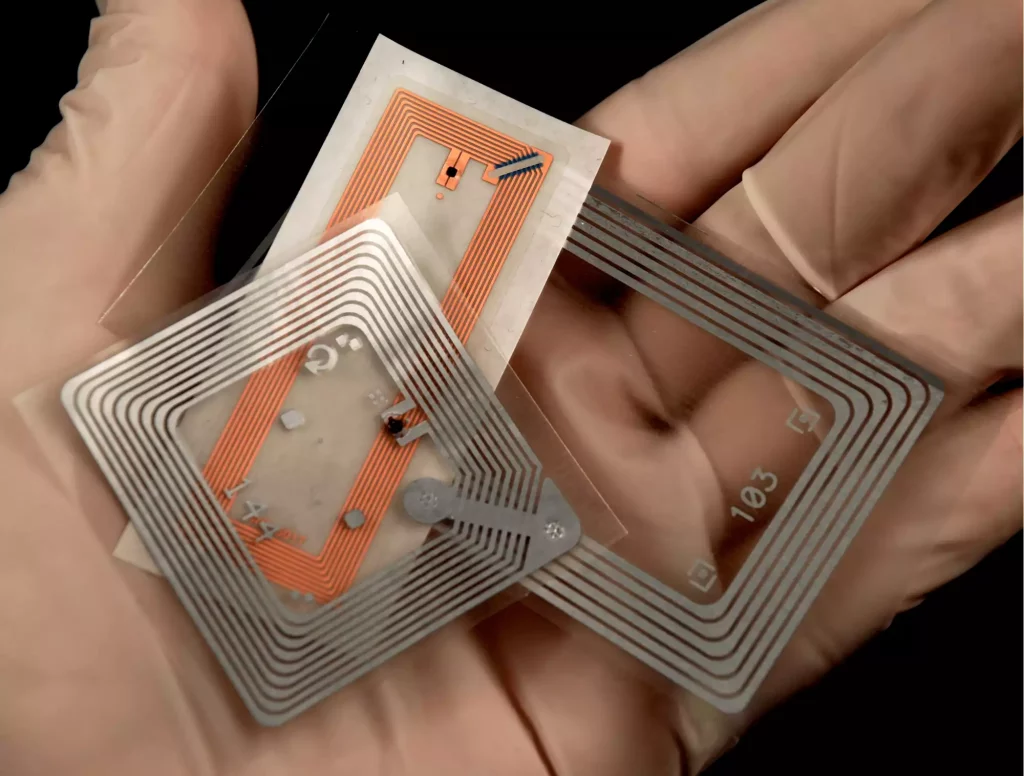What is a BLE beacon? What are the strengths of Bluetooth Low Energy? When can you use these beacons?
It's time to find out.
What is a beacon?
A beacon is a beacon a few centimeters in diameter that uses Bluetooth Low Energy, or BLE, technology to transmit information in the form ofradio waves. It's an active tag, meaning it has its own energy source and emits its own signal. The beacon is made up of several parts:
- A Universal Unique IDentifier, corresponding to a unique identification number
- A radio module
- Sensors
- A microcontroller
- An antenna, whose purpose is to transmit stored information
- A battery, allowing it to operate completely autonomously, without wires!

How does a BLE beacon work?
How beacons work is simple. Let's say we're in a building of several hundred square meters, with several thousand assets. Each asset will be equipped with a beacon, which will emit signals at regular intervals. Fixed antennae, similar in size to WiFi antennae, positioned at specific points in the building, will pick up these signals. Using a triangulation system, and based on the strength of the signal received by the antennae, the system will be able to determine the geolocation of the asset or person to within a metre.
The information received by the antennas is then sent to a BLE Gateway, which acts as a gateway capable of collecting the data. It can then transform them and transmit them to cloud or on-premise servers.
When to use Bluetooth Low Energy beacons
Beacons are extremely practical and compact, making them suitable for a wide range of applications. For example, they can be found on tourist sites. Imagine you have visitors to your park, museum or estate, and you want to send them information as they explore: BLE sensors let you do just that, as long as the dedicated application is active on their smartphone.
But that's not all!
For companies too, beacons are proving strategic. This is particularly true for :
- For asset asset tracking as demonstrated above. If RFID allows you to pinpoint the last location of your asset, with beacons you can visualize the location of your equipment in real time. From pallets and vehicles in outdoor environments, to beds and equipment in hospital logistics: it all depends on your needs.
- To guarantee optimum storage conditions. In addition to simple identification data transfer, BLE beacons can also be fitted with temperature sensors. So, if you have certain traceability requirements, these units make sense.
- For tracking people. Yes, some bracelets are equipped with beacons, so they can determine the precise location of individuals. Depending on the strength of the signals received, the device simply calculates the distances between each element. BLE beacons can also be equipped with accelerometer sensors, so you can be notified if someone falls, for example. Whether in prisons, hospitals or retirement homes, this technology is indispensable.
- For access control. While the idea of a badge may seem outdated and time-consuming, the BLE versions are really interesting. All you have to do is position a beacon in a strategic location on your premises, and you're in business. Every smartphone in the vicinity will be detected and validated (or not!) by the system, acting as an automatic badge.
Beacons are therefore invaluable allies when it comes tooptimizing flows and inventory management, and simplifying decision-making at the same time. By extension, your profitability and your staff's well-being are enhanced.
Advantages and limitations of BLE beacons
What are the advantages of BLE beacon technology?
Among the greatest strengths of BLE beacons, let's highlight 4:
- Long service life: As the acronym BLE (Bluetooth Low Energy) suggests, beacons using this communication protocol consume very little energy. You can therefore easily expect a lifespan of over 5 years, which makes sense in an industrial context.
- Precision: They offer the same high level of precision as NFC, but with a much greater range.
- Autonomy: BLE beacons are so popular because they require no wires to operate. With their own battery, they can be moved around at will, and require very little logistical effort.
- Simple implementation: Since the frequencies used by Bluetooth Low Energy are identical to those of Wi-Fi, i.e. 2.4 GHz, they are easy to use. The infrastructure required is similar to that of Wi-Fi.
The limits of a Bluetooth beacon
Your questions about Bluetooth Low Energy beacons
Geolocation: BLE or RFID tags?
You are probably hesitating between RFID systems and beacons to manage your assets and inventory. In this case, you should be aware that these two technologies do not cover the same needs. If you want to optimize stock management, eliminate inventory discrepancies and carry out your inventories almost automatically, then RFID technology will be more suitable. However, if you want to geolocate assets or people in real time, then Bluetooth Low Energy will be more appropriate.
In terms of price, BLE beacons are more expensive than RFID tags, but for a complete solution, a number of factors need to be taken into account, such as antennas, terminals, the number of assets to be tracked, etc. All of these factors will vary the final price, which means that a BLE system is not necessarily more expensive than an RFID system.
In concrete terms, then, we can say that BLE technology and radio identification are complementary. Only a detailed analysis of your needs will enable us to redirect you towards one or other of these solutions.
When were beacons created?
As you can see, connected objects are extremely promising for managing your inventory, assets and visitors. Following in the footsteps of RFID, BLE beacons are now being used on a large scale, enabling signals to be sent over long distances. Would you like to find out more, or implement such technology in your company? Contact our experts today. We'll take care of everything, from defining your needs to system maintenance, installation and testing.

SolAsset, SolSample, SolShow...







